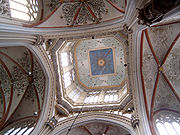
St. John's Cathedral, 's-Hertogenbosch
Encyclopedia



North Brabant
North Brabant , sometimes called Brabant, is a province of the Netherlands, located in the south of the country, bordered by Belgium in the south, the Meuse River in the north, Limburg in the east and Zeeland in the west.- History :...
, Netherlands
Netherlands
The Netherlands is a constituent country of the Kingdom of the Netherlands, located mainly in North-West Europe and with several islands in the Caribbean. Mainland Netherlands borders the North Sea to the north and west, Belgium to the south, and Germany to the east, and shares maritime borders...
. It has an extensive and richly decorated interior, and serves as the cathedral for the bishopric of 's-Hertogenbosch.
The cathedral
Cathedral
A cathedral is a Christian church that contains the seat of a bishop...
has a total length of 115 and a width of 62 metres. Its tower reaches 73 metres high.
St. John’s Cathedral is a so-called ‘Kanjermonument’ (whopper-monument, loosely translated) and being such, it receives financial support from the Dutch government.
In 1985, it received the honorary title of basilica
Basilica
The Latin word basilica , was originally used to describe a Roman public building, usually located in the forum of a Roman town. Public basilicas began to appear in Hellenistic cities in the 2nd century BC.The term was also applied to buildings used for religious purposes...
from pope John Paul II
Pope John Paul II
Blessed Pope John Paul II , born Karol Józef Wojtyła , reigned as Pope of the Catholic Church and Sovereign of Vatican City from 16 October 1978 until his death on 2 April 2005, at of age. His was the second-longest documented pontificate, which lasted ; only Pope Pius IX ...
.
History
Originally, the cathedral was built as a parish church, but in 1559, it became thecathedral of the diocese of 's-Hertogenbosch.
A Romanesque church used to stand on the spot where the St. John now resides. Its construction is thought to have started in 1220 and was finished in 1340. Around 1340, building began to extend the church, from which its current gothic style came. The transept and choir were finished in 1450. In 1505, the romanesque church was largely demolished, leaving only its tower. Construction of the gothic St. John was finished about the year 1525.
In the year 1584, a fire broke out in the high wooden crossing tower, more majestic than the current one. Soon the whole tower was set ablaze, and it collapsed upon the cathedral itself, taking with it much of the roof up to point where the organ was situated. In 1830, another fire damaged the western tower, which was repaired by 1842.
Underneath the clock tower there is a carillon
Carillon
A carillon is a musical instrument that is typically housed in a free-standing bell tower, or the belfry of a church or other municipal building. The instrument consists of at least 23 cast bronze, cup-shaped bells, which are played serially to play a melody, or sounded together to play a chord...
. The clockwork can be found at the
top of the Romanesque tower.
From 1629 to 1810, a Protestant minority used the church, which came to be in a heavily dilapidated state. When Napoleon visited the town in 1810, he restored the building to the Catholics.
Restorations
The first restoration of the cathedral lasted from 1859 to 1946. A second attempt at restoration was executed from 1961 to 1985. The third and most recent restoration started in 1998 and was completed in 2010, costing more than 48 million euro. Major parts of the building are once again covered by scaffolding erected for restoration of the outer stonework, but also, ironically, to remedy mistakes made by earlier restoration attempts.Angel with a mobile phone
During the restoration 25 new angels statues had been created by sculptor Ton Mooy, including the one with a modern twist. The last angel in the series holds a mobile phone and also wears jeans. "The phone has just one button, says the artist. - It dials directly to God". The mobile-using angel had to be first approved by the cathedral's fathers, who rejected earlier designs with the jet engines on the angel's back.The Organ
|
|
|
|

